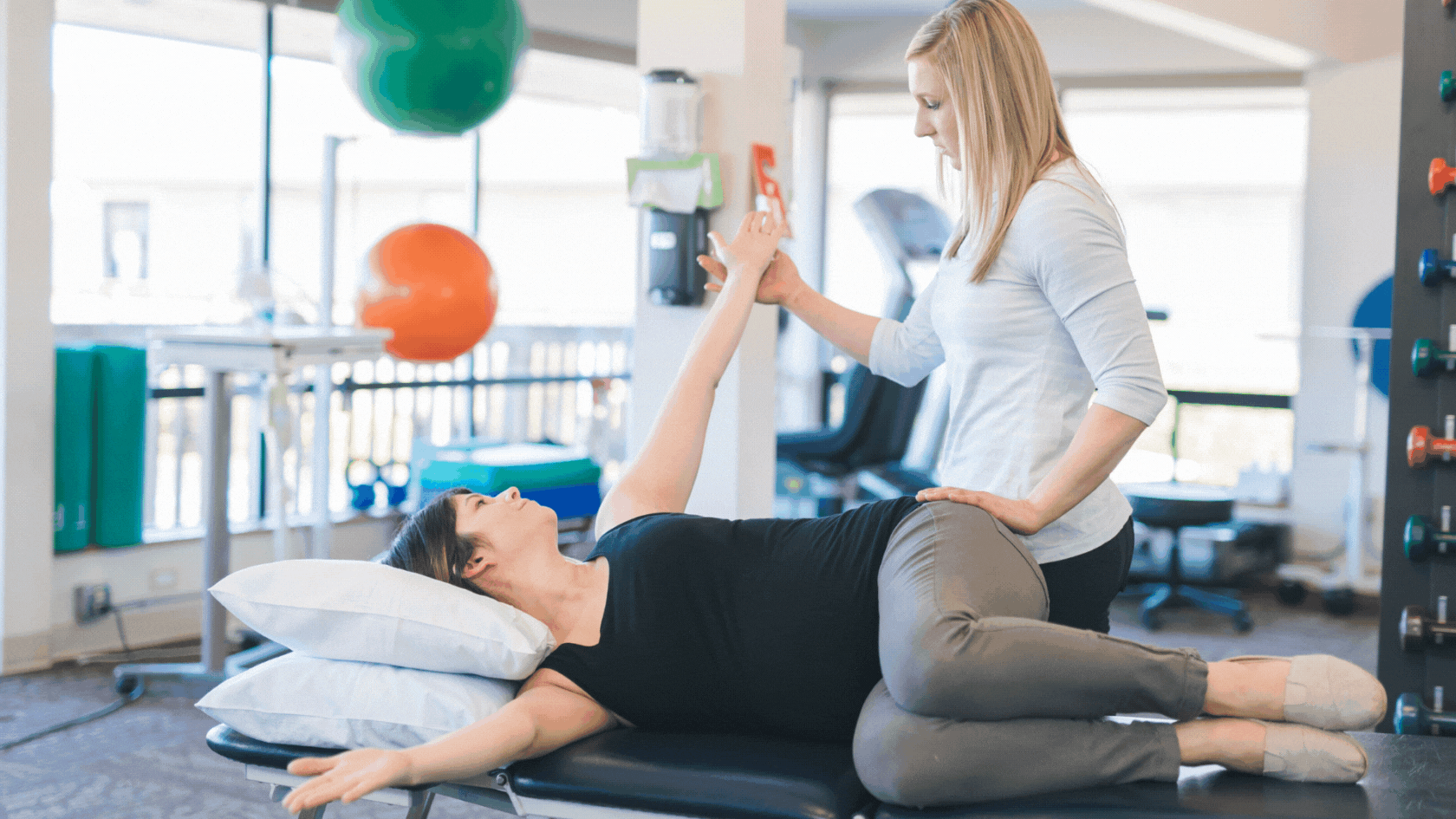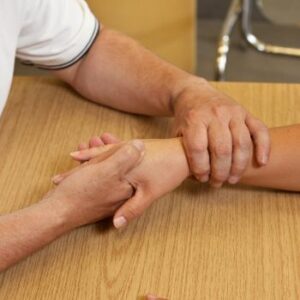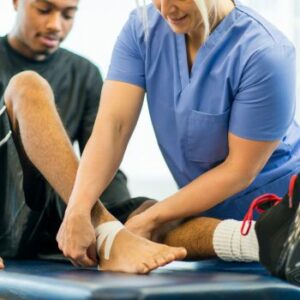
Welcome to H&D Physical Therapy 30 East 60th Street! At our clinic, we believe in making high-quality physical therapy accessible and convenient for everyone. Direct access allows you to receive expert care without the need for a physician's referral, enabling quicker diagnosis and treatment of your pain or mobility issues. Our team of experienced therapists is dedicated to providing personalized, evidence-based care to help you achieve your health and wellness goals. Experience the benefits of immediate attention and a tailored treatment plan designed to get you back to your best self, faster.
Hand Therapy for Neurological Conditions
Hand therapy is a specialized area of rehabilitation focused on restoring function and mobility to the hands and upper extremities. It involves a combination of techniques, exercises, and modalities designed to address various neurological conditions affecting the hands, such as stroke, traumatic brain injury, multiple sclerosis, and peripheral nerve injuries. Continue reading to learn the importance of hand therapy for neurological conditions with H&D Physical Therapy.
Importance of Hand Therapy for Neurological Conditions
- Stroke Rehabilitation - Stroke is one of the leading causes of neurological impairments affecting hand function. Individuals who have suffered a stroke often experience weakness, loss of sensation, and impaired coordination in their hands. Hand therapy plays a crucial role in stroke rehabilitation by helping patients regain strength, improve dexterity, and relearn essential activities of daily living, such as grasping objects, buttoning clothes, and writing.
- Traumatic Brain Injury (TBI) - Traumatic brain injury can result in various neurological deficits, including paralysis, muscle spasticity, and sensory disturbances in the hands. Hand therapy interventions aim to enhance motor control, reduce muscle tone abnormalities, and promote sensory re-education to optimize hand function following TBI. Individuals can regain independence and participate more fully in daily tasks through tailored exercises and activities.
- Multiple Sclerosis (MS) - Multiple sclerosis is a chronic autoimmune disease affecting the central nervous system, leading to a wide range of symptoms, including weakness, numbness, and tremors in the hands. Hand therapy focuses on managing these symptoms through strengthening exercises, adaptive equipment, and ergonomic modifications to enhance functional abilities and improve quality of life for individuals living with MS.
- Peripheral Nerve Injuries - Peripheral nerve injuries, such as carpal tunnel syndrome or radial nerve palsy, can result in motor and sensory deficits in the hands. Hand therapy interventions may include splinting, manual techniques, and nerve gliding exercises to facilitate nerve regeneration, reduce pain, and restore optimal hand function. Hand therapists help patients achieve meaningful improvements in hand mobility and sensation by addressing underlying nerve damage and promoting tissue healing.
The Role of Hand Therapists
Hand therapists are highly skilled occupational or physical therapists with specialized training in treating upper extremity conditions. They work closely with patients to develop individualized treatment plans tailored to their needs and goals. Hand therapists utilize a holistic approach incorporating evidence-based practices, patient education, and ongoing assessment to optimize outcomes and promote long-term success.
Treatment Modalities in Hand Therapy
- Therapeutic Exercises - Therapeutic hand therapy NYC are a cornerstone of hand therapy, aimed at improving strength, flexibility, and range of motion in the hands and fingers. These exercises may include grip strengthening, finger isolation drills, and functional activities tailored to the individual's level of impairment and functional goals.
- Splinting - Splinting is often used in hand therapy to immobilize injured joints, protect healing tissues, and optimize hand alignment. Custom-made splints provide support and stability while allowing for controlled movement during activities of daily living. Hand therapists meticulously design and adjust splints to ensure proper fit and functionality, promoting optimal healing and recovery.
- Manual Therapy - Manual therapy techniques at H&D, such as soft tissue mobilization, joint mobilization, and scar management, are employed to address musculoskeletal issues and promote tissue healing in the hands. These hands-on interventions help improve joint mobility, reduce pain, and enhance overall function, allowing patients to regain confidence and independence in their daily life.
- Neuromuscular Re-education - Neuromuscular re-education focuses on restoring normal movement patterns and sensory awareness in individuals with neurological impairments. Through repetitive tasks, sensory stimulation, and proprioceptive exercises, hand therapists help rewire the brain and improve motor control, coordination, and proprioception in the hands, facilitating greater independence and functional performance.
Contact Us For Hand Physical Therapy 30 East 60th Street
Hand therapy plays a vital role in the rehabilitation of individuals with neurological conditions affecting the hands. By addressing underlying impairments and promoting functional recovery, hand therapists empower patients to regain independence, improve quality of life, and achieve their potential. With a comprehensive approach that integrates therapeutic exercises, splinting, manual therapy, and neuromuscular re-education, hand therapy offers hope and healing for those navigating the challenges of neurological conditions. Contact H&D Physical Therapy today to learn more about hand therapy.
What is Direct Access Physical Therapy and Why is it Important?
Direct access physical therapy 30 East 60th Street is a revolutionary approach that empowers patients by allowing them to seek physical therapy services without a physician's referral. This model is transforming the healthcare landscape, making physical therapy more accessible and efficient. By bypassing the need for a referral, patients can receive timely care, which is crucial for optimal recovery and overall health.

The Benefits of Direct Access Physical Therapy
- Improved Accessibility - Direct access to physical therapy 30 East 60th Street significantly enhances patient access to physical therapy. Patients no longer need to wait for a doctor's appointment, which can often be a lengthy process. This immediate access can lead to quicker diagnosis and treatment of musculoskeletal issues, reducing the risk of chronic conditions developing from untreated injuries.
- Cost-Effectiveness - By eliminating the referral requirement, direct access can reduce healthcare costs. Patients save money on additional doctor visits and unnecessary diagnostic tests. Furthermore, early intervention through physical therapy can decrease the need for more expensive treatments or surgeries down the line.
- Enhanced Patient Autonomy - Direct access supports patient empowerment and autonomy. Patients can take charge of their health by directly seeking the care they need. This proactive approach can lead to higher patient satisfaction and better health outcomes, as individuals feel more in control of their treatment journey.
- Streamlined Healthcare Process - Removing the referral step streamlines the entire healthcare process. Physical therapists can work directly with patients to develop personalized treatment plans without delays. This efficiency not only benefits patients but also reduces the administrative burden on healthcare providers.
Conditions Treated Under Direct Access
Direct access physical therapy can address a variety of conditions, including:
- Musculoskeletal injuries: Sprains, strains, and fractures.
- Chronic pain: Back pain, neck pain, and arthritis.
- Post-surgical rehabilitation: Recovery and strengthening after surgeries.
- Sports injuries: Tendonitis, ligament tears, and overuse injuries.
- Neurological disorders: Stroke rehabilitation, multiple sclerosis, and Parkinson's disease.
Why Direct Access Physical Therapy is Crucial
- Timely Intervention - Early intervention is critical in physical therapy. Delays in treatment can lead to prolonged pain and disability. Direct access allows patients to begin therapy at the onset of symptoms, leading to faster recovery times and better overall outcomes.
- Preventive Care - Direct access also plays a vital role in preventive care. Physical therapists can identify and address potential issues before they become serious problems. This preventive approach helps maintain patients' health and reduces the likelihood of injuries and chronic conditions.
- Better Long-Term Health Outcomes - Studies have shown that patients who receive early physical therapy intervention tend to have better long-term health outcomes. They experience less pain, improved function, and a higher quality of life compared to those who delay treatment. Direct access facilitates these positive outcomes by providing immediate care.
Contact Us Today - Physical Therapy 30 East 60th Street
Direct access physical therapy is a critical component of modern healthcare. It offers numerous benefits, including improved accessibility, cost-effectiveness, and enhanced patient autonomy. By allowing patients to seek care directly from physical therapists, this model supports timely intervention, preventive care, and better long-term health outcomes. As awareness grows and policies evolve, direct access is set to play an increasingly important role in delivering high-quality, patient-centered care.
Benefits of Physical Therapy for Back Pain
Anyone can develop back pain at any point in their lives. Knowing the risk factors associated with back pain, the cause may be more severe than you think. If you are experiencing back pain and looking for physical therapy 30 East 60th Street, contact us or book an appointment to find the best treatment. Your treatment could reduce or even eliminate your back pain today!
Risk factors that may cause back pain:
Fitness level – Back pain is more common for those who are not physically fit. This is caused by a weakness in the back and stomach muscles that do not properly support the spine. It is also common to exercise too strenuously after being inactive for a long time.
Weight gain – Stress on the back due to weight gain is a common cause of back pain. A diet that consists of high calories and fat with an inactive lifestyle can lead to obesity.
Age – Back pain becomes much more common with age due to stress over time, notably around 45 to 50 years old.
Work-related – Lines of work that consist of persistent heavy lifting, pulling, or compound movements can injure the back or make you more prone to back pain. Even a desk job that requires no physical activity can cause back pain if you have poor posture or sit in an uncomfortable chair for hours at a time.
Disease or conditions – Arthritis, scoliosis, and cancer can lead to back pain. About 80% of back pain only lasts 1-7 days. If it is chronic, it may be caused by arthritis. Pain in the lower back is the most common site of arthritis. Back pain is a rare sign of cancer but can still result from spinal or colorectal cancer. Scoliosis is the curvature of the spine which causes pain.
Heredity – Genetics may contribute to some disorders that cause back pain.

Types of back pain:
Thoracic – The thoracic spine is made up of the twelve vertebrae to which the ribs attach. This is known as the “upper back” region of the spine. A severe underlying condition highly likely causes pain in the thoracic region of the spine. Symptoms to keep an eye out for include fever and chills, unexplainable weight loss, severe stiffness, or nerve tingling and numbness in the legs or lower body.
Middle back – pain that occurs above the lumbar region of the spine but below the rib cage. The symptoms associated with middle back pain can be unclear or difficult to diagnose, which can be annoying, especially for chronic cases. Elements that can cause a person to develop middle back pain include pregnancy, weight gain or obesity, smoking, and lack of physical activity.
Lumbago – Pain that stems from the lower back region that can be caused by several factors caused, primarily by muscle or ligament strain. The main causes can be poor posture, improper or excessive lifting, lack of exercise, arthritis, and ruptured disc(s). Most lower back pain will go away on its own in 2 to 4 weeks and is not usually caused by an underlying disease.
Treatment and prevention:
Stretching – The most important thing you can do is daily stretching exercises that only take a few minutes. It will protect your back from future injuries or conditions and will treat current ones.
Physical therapy and medical massage – These treatments can benefit acute and chronic back conditions. Therapy, exercise programs that can be done at home, or a professional massage will relieve your back pain.
Health – A good exercise and diet routine is imperative to maintain a healthy back and spine. Proper posture and sleeping on your back or side will sustain good spinal support. Eliminating health-impacting vices like excessive smoking or drinking will improve back health.
Surgery – Particularly serious cases may not be treatable through non-invasive means. Standard surgical procedures include discectomy and/or vertebrae fusion. A discectomy involves the removal of all or part of an injured spinal disc, and vertebral infusion focuses on physically joining two adjacent vertebrae to create a strong structure. These surgeries can be performed together in some cases.
The treatment for back pain rests firmly on the location and cause of the pain, but many conditions can be partially or completely treated through these methods. Most can be done at home.
Physical Therapy 30 East 60th Street
Back pain can significantly obstruct daily activities and may affect one’s quality of life. If you are suffering from back pain, it is strongly recommended that you see our medical professionals for a diagnosis. Back pain can be the result of something minor or can have serious underlying causes; we urge you to have it checked out. If you are experiencing back pain, seek physical therapy near Hells Kitchen, like H&D Physical Therapy today!
Physical Therapy For Lower Back And Hip Pain Relief Is Essential
Persistent discomfort can severely impact daily life and overall wellness. Engaging in rehabilitation is integral for those experiencing issues related to lower back and hip regions. Factors contributing to these discomforts often include muscle strain, injury, and inadequate posture. Implementing targeted stretching techniques and core strengthening routines can enhance flexibility and stability. For improved hip mobility, maintaining postural alignment alongside ergonomic adjustments is crucial for optimal movement. These strategies facilitate muscle relaxation and support long-term recovery from pain, paving the way for a healthier lifestyle.
Rehabilitation Techniques For Lower Back Pain
Addressing discomfort in the lower back requires a multifaceted approach to care. Physical therapy techniques form the cornerstone of effective rehabilitation strategies for diverse conditions. Neuromuscular therapy can help enhance muscle function and alleviate pain. Range of motion exercises are crucial for maintaining mobility and preventing stiffness. Therapeutic modalities like ultrasound and electrical stimulation provide pain relief and facilitate healing. Kinesiology principles guide practitioners in developing personalized exercise regimens focused on improving strength and flexibility training. Manual therapy techniques, including myofascial release, can effectively target pain relief and promote healing. Education about joint stability enhances patient empowerment in managing their condition autonomously. Through these methodologies, patients can experience significant improvements during their recovery journey.
Therapeutic Exercises For Core Strengthening
Engaging in specific exercises is beneficial for enhancing overall physical well-being. Incorporating muscle strengthening routines not only contributes to improved stability but also supports lower back health. By focusing on balance exercises, individuals can work towards better coordination and posture correction. Utilizing rehabilitation equipment like resistance bands and stability balls facilitates effective workouts for all fitness levels. Chronic pain can often be alleviated through consistent practice, leading to health optimization. Proper technique is necessary to prevent injury while maximizing the advantages of these movements. Always seek personalized guidance to ensure your exercise plan aligns with individual needs and enhances physical therapy for lower back and hip pain relief.
Physical Well-Being Exercises
- Muscle strengthening routines can enhance stability and support lower back health.
- Balance exercises improve coordination and contribute to better posture.
- Using rehabilitation equipment like resistance bands and stability balls allows for effective workouts suitable for all fitness levels.
- Consistent practice can alleviate chronic pain and lead to overall health optimization.

You must be logged in to post a comment.